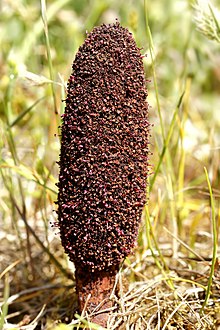Cynomorium coccineum
From Wikipedia, the free encyclopedia
| Cynomorium coccineum | |
|---|---|
 | |
| Cynomorium coccineum | |
| Scientific classification | |
| Kingdom: | Plantae |
| (unranked): | Angiosperms |
| Order: | Incertae sedis |
| Family: | Cynomoriaceae Endl. ex Lindl.[1] |
| Genus: | Cynomorium L. |
Contents
Description[edit]
The plant has no chlorophyll and is unable to photosynthesise. It is a geophyte, spending most of its life underground, in the form of a rhizome, which is attached to the roots of its host plant; it is a holoparasite, i.e. totally dependent on its host. The low-growing inflorescence emerges (in spring, following winter rain), on a fleshy, unbranched stem (most of which is underground) with scale-like, membranous leaves. Dark-red or purplish, the inflorescence consists of a dense, erect, club-shaped mass, some 15–30 cm long (6–12 in), of minute scarlet flowers, which may be male, female or hermaphrodite.[4] It is pollinated by flies, attracted to the plant by its sweet, slightly cabbage-like odour. Once pollinated the spike turns black.[3] The fruit is a small, indehiscent nut.[5]In the Mediterranean region, Cynomorium is a parasite of salt-tolerant plants in the Cistaceae (cistus family) or Amaranthaceae (amaranth family); elsewhere it parasitizes Amaranthaceae, Tamaricaceae (tamarisks) and, in China, Nitrariaceae,[6] especially Nitraria sibirica. Other authorities suggest the host plants are saltbushes (Atriplex species, Chenopodiaceae).[3]
DNA studies suggest that Cynomorium is not a member of the Balanophoraceae, as previously thought, but more probably belongs to the Saxifragales, possibly near Crassulaceae (stonecrop family).[7]
- Emerging inflorescence in the desert in Jordan
Distribution[edit]
Cynomorium coccineum var. coccineum[8] is found in Mediterranean regions, from Lanzarote in the Canary Islands and Mauritania through Tunisia and Bahrain in the south; Spain, Portugal, southern Italy, Sardinia,Sicily, Gozo, Malta and the Eastern Mediterranean. Its range extends as far east as Afghanistan, Saudi Arabia and Iran.Cynomorium coccineum var. songaricum[9] is found in Central Asia and Mongolia, where it grows at high altitudes. Several authorities consider this to be a separate species, C. songaricum; it is called "suo yang" in China, where it is extensively collected as a herbal remedy for illnesses including sexual worries and nocturnal emissions.[7][10]
History and historical uses[edit]
Sir David Attenborough has suggested that, following the reasoning of the "Doctrine of signatures", the phallic shape of the inflorescence suggested to early herbalists that Cynomorium should be used as a cure for erectile dysfunction and other sexual problems. Its colour suggested that it would cure anaemia and other diseases of the blood.[3] It has been used for similar purposes in the east and west of its range: crusaders carried dried spikes to help them recover from their wounds.[3]Other uses have included treatments for apoplexy, dysentery, sexually transmitted diseases, hypertension, vomiting and irregular menstruation.[3]
A city in China, near Anxi in what is now Gansu Province, was named Suoyang (the Chinese name for Cynomorium) after 7th-century General Xue Rengui and his army survived a siege there by eating the plant.[3] Much later, it was "introduced" (or imported?) to China from Mongolia during the Yuan Dynasty as a medicinal plant, and is first mentioned by Zhu Danxi in Bencao Yanyi Buyi (Supplement and Expansion of Materia Medica) in 1347. It was an ingredient in his recipe for Huquian Wan (Hidden Tiger Pills) used for impotence and/or weak legs.[3]
During the 16th century, the Knights of Malta prized the plant greatly, and sent samples to European royalty. They incorrectly believed it to be a fungus and it became known as "fungus melitensis", "Maltese Mushroom". The Knights jealously guarded "Fungus Rock" (a large rock formation, on whose flat top it grew in abundance) just off the coast of Gozo. They even tried smoothing the outcrop's sides to prevent theft of the plants, which was said to be punishable by death. The only access was by a precarious cable car, which was maintained into the early 19th century. The rock is now a nature reserve, so access is still strictly limited.[3]
In the Middle Ages, Arabic physicians called it "tarthuth" and "the treasure of drugs". An aqrabadhin or medical formulary complied by Al-Kindi in the 9th century lists tarthuth as an ingredient in a salve to relieve skin irritation; later, Rhazes (Al-Razi) recommended it to cure piles, nosebleeds and dysfunctional uterine bleeding.[3]
In Saudi Arabia, where Cynomorium is called "tarthuth", in addition to the uses detailed above, an infusion made from the ground, dried mature spike has been used to treat colic and stomach ulcers. It was eaten on long journeys by the Bedouin people, who would clean and peel the fresh spikes and eat the crisp white interior, which is said to be succulent and sweet, with a flavour of apples and a pleasantly astringent effect. It is also relished by camels.[3]
It has often been used as a "famine food" (last reported during the 19th century in the Canary Islands). Among many other uses it has been used as a contraceptive, a toothpaste and a non-fading crimson fabric dye![3]
- "Fungus coccineus Melitensis Typhoides" from Icones et Descriptiones rariarum plantarum…, Paolo Boccone (1674)
- "Cynomorion" fromNova plantarum genera, Pier Antonio Micheli (1729)
- "Malteserschwamm" (with "Cytinus hypocistus" [sic], left) from Pflanzenleben: Erster Band: Der Bau und die Eigenschaften der Pflanzen, by Anton Joseph Kerner von Marilaun and Adolf Hansen (1913)
Active ingredients[edit]
Cynomorium contains anthocyanic glycosides, triterpenoid saponins, and lignans.[3]Research being carried out into the plants' actual medicinal properties seems to provisionally confirm several of the traditional uses. Extracts of the herb appear to inhibit HIV, improve blood flow and lower blood pressure. It may also have a hormonal effect that would confirm its efficacy in treating impotence.[3]






No comments:
Post a Comment